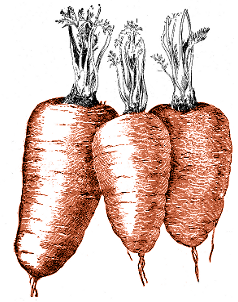Posts tagged ‘calendula’
Posted in Decorative, Experimentation, Garden Diary, Practicalities, The Old Garden In Bristol on Sunday, April 17th 2016 (9.18 PM).
This afternoon, I finished weeding the rosebay willowherb, until more shoots spring up at least. Weeded every shoot I could see, dug up every rhizome I could find, levelled out the soil and spread a layer of compost across the top.
The sowing plan for the bed starts with: peas at the back, against the trellis. Now, I’ve had issues with pea support in the past, and I suspected that the laths of the trellis are a bit big for a pea plant to wrap a tendril around, so the trellis has been covered in green plastic pea netting. It’s not the prettiest solution but it’s not too obtrusive; and I’m sure the vines of the back neighbour’s honeysuckle will love clinging onto it too.
In the front of the bed, we have scattered various seeds, mostly flowers, in the hope that the will grow up in front of the pea plants without eclipsing them entirely. We’ve scattered handfuls of:
- Cornflower, Centaurea cyanoides “Blue Diadem”
- Night scented stocks, Matthiola bicornis
- Corn marigold, Chrysanthemum segetum
- Poppy, Papaver rhoeas “Flanders”
- Swiss chard, Beta vulgaris vulgaris Cicla-Group “Five Colour Silverbeet”, because Gretchen has spotted it elsewhere and liked the different colours of the leaves.
- Tree spinach, Chenopodium giganticum “Magenta Spreen”, scattered from a packet I bought a couple of years ago and intended to sow but never did. The aim of the tree spinach is much as it was when I bought the packet: it has been sowed in the left-hand end of the bed, a dark and fairly damp corner where not much grows apart from dandelions. Tree spinach might prefer sun, but will hopefully cope with the shade there; and there won’t be any peas at that end that it might crowd out.
There are also nasturtiums, Tropaeolum majus “Empress of India”, apparently “a classic Victorian variety” according to the Internet, sowed in a couple of spots, their seeds like tiny miniature brains. The key to all of this, of course, is the idea that the peas are going to clamber up high enough and quick enough that none of the stuff around them will cause any problems. The other key, which you might have realised, is that nearly all of the ornamental (or semi-ornamental) stuff is self-seeding. Hopefully, once everything is set up, everything will keep on going year after year, or at least until we move house.
This is all very experimental and no doubt a Proper Gardener would tell us we were trying to cram far too many plants into a tiny space. However, we will wait and see. I won’t be surprised if not everything develops, or at least, doesn’t grow exactly how I originally envisaged things. It might need a bit of tweaking next year, or it might all come up again, irregular but satisfactory.
I’ve given up on the calendula seeds mentioned previously, and bought a new packet. Into pots, we sowed:
- More calendula, obviously.
- And more Tropaeolum majus.
- Mixed rocket leaves
- A different dwarf sunflower, Helianthus annuus “Choco Sun”, allegedly one of the smallest sunflower varieties available. Short enough for a toddler to sniff, I hope.
And with a general tidy-up, the garden is looking reasonable again. The back bed may be bare soil now, but hopefully within a month or two it will be full of greenery, and mostly the greenery we intended, too. In the tidy-up a lot of the wooden containers were thrown away, their wood rotted too far to save them, but that leaves us a good terracotta core. The plants we bought and potted up 2½ weeks ago are settling in nicely: the fennel looking lively, the thymes putting on new growth, and the marjoram already starting to fill up its pot. I’m rather pleased with how quickly things have been turned around. Even if things aren’t perfect yet, there’s not too much more tidying up left to do.
calendula, chard, corn marigold, cornflower, creeping thyme, fennel, french marjoram, green fennel, lemon thyme, marigold, marjoram, nasturtium, pea, poppy, rosebay willowherb, sowing, sowing plan, sunflower, swiss chard, thyme, tree spinach, weeding, Tropaeolum
Posted in Experimentation, Garden Diary, Practicalities, The Old Garden In Bristol on Thursday, April 14th 2016 (9.46 PM).
The first few pea shoots started to break the surface a couple of days ago, making it five days after sowing. Rather fast, I thought; only a few have come up so far, which makes me worry I’ve kept them too damp or something.
In the meantime I’ve been clearing out the back bed, into which the peas are going to be transplanted once large enough. A few years ago, I spent weeks clearing bindweed out of it, going through the soil archaeologically to excavate the tiniest pieces of bindweed rhizome. Now, after a couple of years of baby-rearing abandonment, it’s been colonised by rosebay willowherb. So I’m going through the soil almost archaeologically again, pulling out chunky pieces of rosebay willowherb rhizome this time. Hopefully I have got as much as possible: if I’ve missed any, once there are other plants in there the archaeological approach isn’t likely to work very well. I will have to resort to pulling up each shoot again and again until the rhizomes are exhausted.
There is still no signs of the calendula seeds we sowed twelve days ago germinating. To be honest I have no idea how long they normally take to germinate, but as I usually tend towards the impatient side, and I was always a bit skeptical that the packet would still contain viable seeds, I am suspecting that nothing is going to appear. Pushing on ahead, today we planted a pot of borage seeds (Borage officinalis) and another of poached eggs, which is hardly the nicest plant name I’ve ever come across, so I think I’ll just refer to it as Limnanthes douglasii from now on. Both pots will only really be large enough for one plant of each; a rather small plant in the borage’s case; but that will suffice. There may be just enough room for one borage plant in the back bed too, in front of the peas, but I doubt it with everything else I’d like to squeeze in there.
We did also buy a few plants from the greenhouse at St Werburghs City Farm, which sells plants as part of its horticulture training scheme for adults with special needs. A couple of chervil (Anthriscus cerefolium) and a dwarf variety of sunflower, which hopefully should grow to about the same height as the children. They were repotted this afternoon, despite a cold shower of rain, and with the children “helping” moving the compost about.
borage, calendula, chervil, germination, limnanthes douglasii, pea, rosebay willowherb, sowing, sunflower, weeding
Posted in Children, Decorative, Experimentation, Garden Diary, The Old Garden In Bristol on Monday, April 4th 2016 (10.36 PM).
The gardening was certainly a hit with the children: the first thing they wanted to tell the child-minder the next time they went to see her. Indeed, most days since then they have asked, at some point, to help in the garden. They now have a small watering can. The watering can may have been a mistake. They like watering, maybe a bit too much. For The Child Who Likes Animals, their watering can just isn’t enough: he has to grab hold of the big watering can and take charge of that. The Child Who Likes Fairies is happy with the small one, but every time it’s empty there is a cry of “More water!”
We have acquired and re-potted another new plant from the garden centre: a lavender, Lavandula x intermedia “Vera”. A small one-litre plant at the moment, we’ve put it into a wide plastic thing in the hope that it will grow into it and never need repotting ever again.
Now, I’ve heard the theory that planting a small plant into a big pot that it doesn’t really need doesn’t do very much for the health of the plant; it just gives it chance to get a bit “pot-drunk” and doesn’t really translate into long-term healthiness. It sounds like a strange idea, though. I wouldn’t be surprised if maybe the plant doesn’t grow quite as fast above-ground, because it will put more work into extending its roots. However, even in a container, good roots are surely rather more important if you want to ensure the plant will live any length of time. I don’t mind if this plant doesn’t grow quite as fast or quite as large, straight away, as if I’d only put it into a three-litre pot initially, if that means it won’t need repotting again in a year’s time. Time will tell, I suppose.
At the same time – this was on Saturday – I planted some seeds with The Child Who Likes Fairies. Calendulas, from a packet that is three-years date expired. On the other hand they were very reliable seeds when I last tried them a few years ago. We have plenty more new ones to try in the coming weeks; I just rather like these calendulas. The interesting part is going to be seeing, if and when they germinate, if TCWLF realises they are the seeds she planted. We do have a packet of dwarf sunflowers in hand to plant, but they have a 3-week germination time. Even I have trouble remembering what I’ve planted where three weeks later.
calendula, dutch lavender, lavender, lavendula
Posted in Garden Diary, The Old Garden In Bristol on Sunday, March 23rd 2014 (9.16 PM).
It hasn’t been a cold winter, but it feels like it’s been a long, wet winter, a winter for slugs and snails. Moreover, the last time I wrote something on this blog, we had zero children in the family. Today, we have two children in the family; things have been a little busy in the past few months.
Spring has sprung, though, and the summer flowers I mentioned previously are starting to bloom. The borage plants have sprung up thick, hairy stems, looking ridiculously large in the box they are growing out of, hanging clusters of buds starting to open. Here’s a picture from a couple of weeks ago, just before they did:
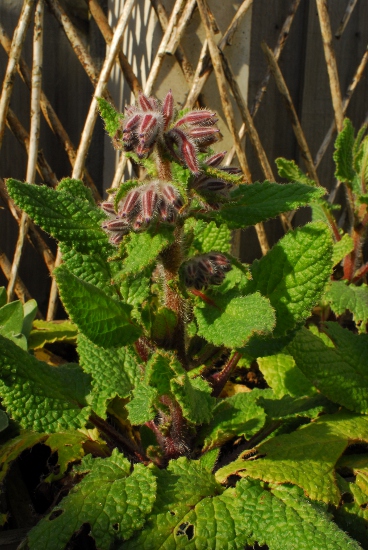
One calendula plant has blossomed; the rest have fat buds nestling in their hearts. One box of the forget-me-nots is a green carpet with one or two small, gemlike lilac flowers starting to appear.
Strangely, though, not all of the flowers are doing as well as the others. We planted five boxes, in a line on top of the garden wall, borage in the middle, calendula either side, forget-me-nots at either end. The two boxes on the shadier side of the borage are doing very well; on the other side, the calendula has a couple of slightly sick-looking plants in it, and the forget-me-not box has a couple of small seedlings, hardly anything compared to the thick growth at the other end of the wall. If anything, I would have thought things would have gone the opposite way around, and the sunnier boxes would be those doing best.
The white clover we planted as a green manure had also flowered, beautiful tiny white flowers. It was probably supposed to be dug in before that happened; never mind. Today, I turned it all over, and also tried to get up the taproots of a couple of dandelions that had settled in there over the winter. No doubt I didn’t quite manage to dig all over the clover up; I’m not really bothered if I didn’t. If we ever have a garden large enough for a lawn, I’d much rather fill the space with camomile, clover, and other similar low-growing plants. Next week, after the clover has started to rot down, I will try to make sure I sow something else.
borage, calendula, clover, forget-me-not, white clover
Posted in Environmentalism, Garden Diary, The Old Garden In Bristol on Saturday, September 14th 2013 (10.32 PM).
There is one benefit, of course, to leaving the garden to go to seed for a year. It means that the wildlife can get along with things all on their own, without me coming along to pull up their homes and generally keep disturbing things. Whilst clearing the garden up in the past few weeks, we’ve seen lots of shieldbugs, crab spiders, caterpillars, various different insects and suchlike going about their own business and making the most of the place.
A couple of years ago, we bought a bee house, and nailed it up on the wall of the shed. It saw little use, to be honest, apart from by spiders and a couple of holes filled by a mason bee last year. This summer, though, leafcutter bees have found it, and made good use of it.
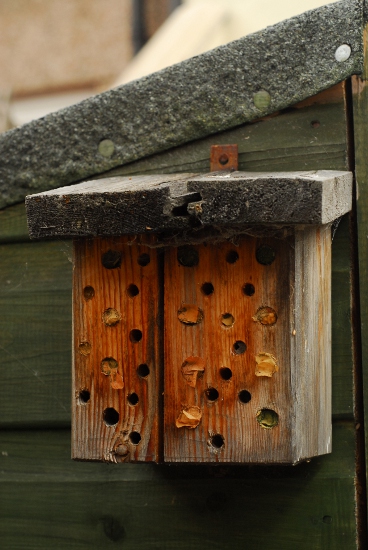
As you can see from the picture, leafcutter bees are quite picky about the sizes of the holes they will lay eggs in. You can also see one of the holes which a mason bee presumably crawled out of earlier in the year. Hopefully, at some point in the spring, a family of newly-mature leafcutter bees will emerge again.
In other news, we have sowed a few flowers ready for next summer: calendula, forget-me-not and borage. Slowly we’re drifting away from the original idea of making the garden as edible as we could, but that was never a strictly hard-and-fast rule to start with. They are, at least, all flowers which should please the leafcutters and bumblebees at various times next spring and summer. On the herb front, we’ve acquired a few stems of bay, and planted them in one of the wastebins used in previous seasons for growing potatoes. Growing potatoes is difficult to justify in a garden the size of ours; hopefully the bay will make a bush to last for a few years to come.
bay, bee, bee house, borage, calendula, forget-me-not, leafcutter
Posted in Garden Diary, Photobloggery, The Old Garden In Bristol on Saturday, December 1st 2012 (8.36 PM).
This week, it really feels as if the garden is properly getting itself going. More and more insects are out and about, and more things are starting to come alive. The lettuce and calendulas sown three weeks ago have just made their first appearance above ground, and the pea seedlings which have been growing on the kitchen windowsill are getting larger and larger, stretching their tendrils like the most grotesque of scarecrows. Today I started hardening them off ready for planting out; I probably should have done it earlier.
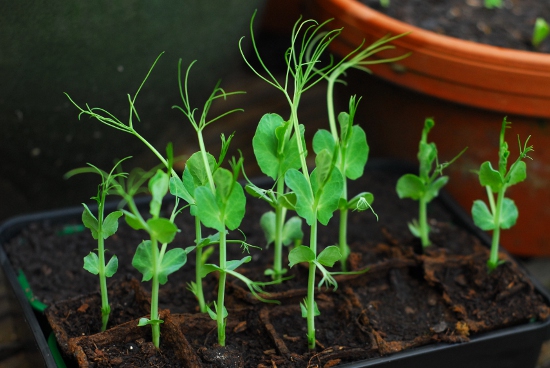
More peas will start germinating soon. The first batch of this year’s potato crop went into the ground today too – well, into their container. This year we picked Red Duke Of York, as something we are unlikely to see in the greengrocers, and I’ve tried to squeeze four tubers into the container rather than last year’s three. The second batch will be planted in about a month’s time.
To get the potatoes, we popped over to the Riverside in Southville. Naturally, we were rather tempted by their selection of herb plants. Possibly too tempted: intending go there purely to get potatoes, we also came home with a black peppermint, some sweet peas, and two fennel plants. The fennel is instead of the dill we grew last year; I will explain more about that later.
black peppermint, calendula, fennel, lettuce, marigold, mint, pea, peppermint, potato, spring, sweet pea
Posted in Experimentation, Garden Diary, The Old Garden In Bristol on Wednesday, February 29th 2012 (5.51 PM).
In the last post, I mentioned that although the rocket is in bloom already, there weren’t any hoverflies about yet. The very next day, I saw the first I’ve seen this year. Orange and black, it had gone before I had chance to grab the camera. It was warm in Sunday’s sunshine, and I could occasionally also hear bumblebees nearby – presumably queens looking for a nesting spot. The only one I saw was a good twenty feet away, not quite close enough to attempt an identification.
I was in the garden, because I’d decided that, with the weather being so warm, it was about time I started getting some seeds in the ground. Don’t want to leave it too late, after all: last year, because of when we started, we didn’t exactly grow the mixture of things we wanted. So Sunday was spent clearing compost out of all the pots which had had last year’s annuals in, and sowing a very few new seeds. In one pot: a mixture of calendulas and lettuce. A bit of an experimental mixture, and I’m not at all sure I have given them enough space to get along. Indoors, on the kitchen window sill: peas, germinating inside to avoid tempting the local wildlife. Peas are damn tasty, after all.
calendula, hoverfly, lettuce, little gem, marigold, pea, sowing, spring, wildlife
Posted in Retrospective, The Old Garden In Bristol on Saturday, October 1st 2011 (11.10 AM).
The list, in the previous post, of plants we’ve grown this year wasn’t really in any particular order; just off the top of my head as I cast my mind around the garden. Here, though, are some of the plants that we can say were a success.
Potatoes: probably our biggest success, grown in a dustbin with holes drilled in the bottom. We grew them in a mixture of soil and compost, at first, earthing up regularly with compost until it reached the top of the bin. I was expecting flowers and fruit, which we didn’t get; and we were rather worried about a leafhopper infestation which developed, damaging the leaves quite a bit. When the foliage died back, though, we upended the bin and found a healthy crop, about 600g per seed. Next year, we hope to have room for a couple more bins.
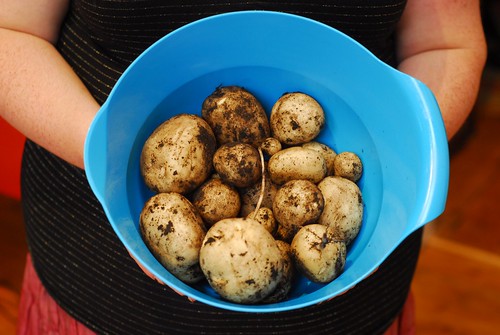
Peas: we bought small plants from the garden centre, planted them up in wine boxes, and put them on top of the garden wall, trained up the latticework. Again, each plant gave us a plentiful harvest; but we did have a bit of a mildew problem, probably caused by planting too many in each box.
French marigolds: we didn’t manage to eat any, but the plants themselves have gone happily on producing flowers all summer. They’re still in flower now, with more buds on the way.
Swiss chard: we planted this in a variety of containers, and tried harvesting and eating it at a variety of stages, from baby leaves to fully-grown leaves and stems. All of them worked pretty well: the baby leaves were ready fairly fast, and harvesting most of those left room for a few plants to grow into adulthood. Moreover, what we weren’t expecting was that we would be able to treat the adult plants in a cut-and-come-again fashion; we thought we’d harvested everything we could a few weeks back, but we now have healthy and harvestable leaves waiting for us again.
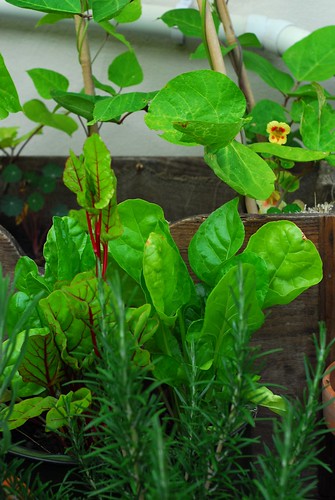
Mint: it grew, despite the best attempts of leaf-miners and caterpillars to eat it. Moreover, we kept forgetting we had mint leaves to use, leaving the mint bush to get rather overgrown and straggly; giving it a fierce trim rather more often would have left us with a healthier plant.
Feverfew: it grew very well, with attractive clusters of daisy-like flowers that have lasted well all summer. Now, we just have to work out what else it might be useful for.
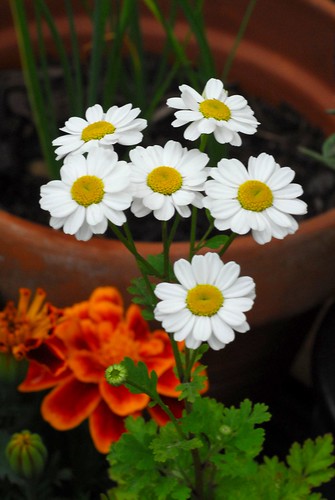
calendula, feverfew, french marigold, marigold, mint, pea, pentland early, potato, review, swiss chard

